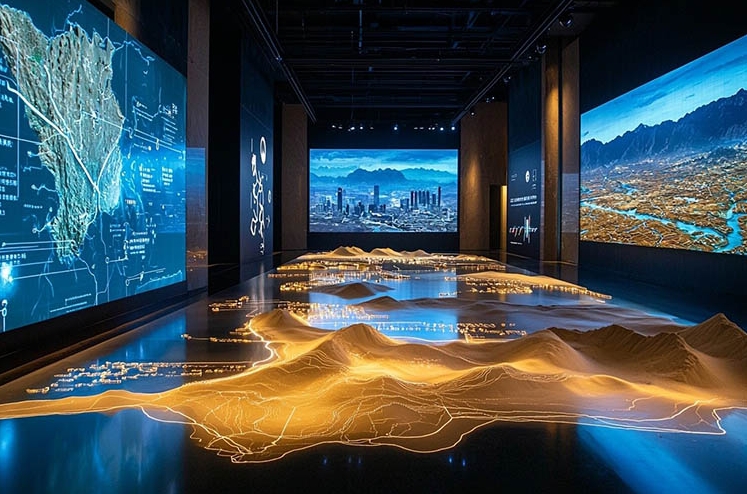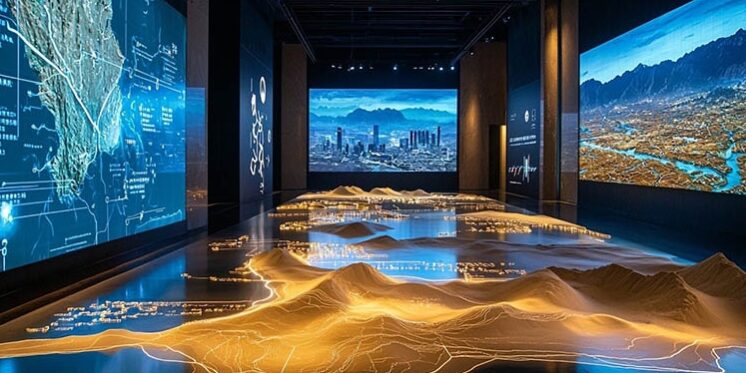Urban planning museums have long served as a vital window into a city’s future, acting as a showcase for development blueprints and civic aspirations. Traditionally, these spaces relied on static models, text-heavy panels, and one-way video presentations to convey their messages. However, the digital wave has ushered in a new era, redefining how these museums narrate stories and engage the public. Today, cutting-edge multimedia technologies are turning planning museums into immersive hubs of exploration, where visitors don’t just observe but actively participate in shaping the urban narrative. In this article, we’ll dive into the most impactful multimedia tools—Digital Sandboxes, AI Digital Humans, and Interactive Projections—that are enhancing visitor experiences and fostering a deeper connection with urban futures.

Why Multimedia Matters in Urban Planning Museums
In an age where attention spans are fleeting, static displays often fail to captivate modern audiences. Multimedia technologies bridge this gap by creating dynamic, interactive environments that invite curiosity and dialogue. These tools not only make complex urban planning concepts accessible but also empower visitors to feel like active contributors to their city’s story. By leveraging sensory engagement and real-time interaction, planning museums can transform from mere information hubs into unforgettable journeys of discovery. Let’s explore three standout technologies leading this revolution.
Digital Sandboxes: From Static Models to Dynamic Simulations
A New Way to Visualize Urban Evolution
Gone are the days when sandboxes in planning museums were just miniature city replicas meant for passive observation. With the advent of digital sandboxes, these exhibits have evolved into powerful decision-making platforms. Integrating high-definition projections, precise sensors, and advanced 3D rendering, digital sandboxes allow visitors to interact with urban landscapes in real time. A simple touch on an interactive screen can animate city textures, revealing intricate details of infrastructure growth or zoning changes.
Empowering Visitors as Decision-Makers
What makes this technology truly transformative is its ability to turn spectators into participants. Visitors can simulate urban development scenarios, experimenting with different planning choices and instantly seeing their impact. This hands-on approach demystifies the complexities of urban planning, helping audiences grasp the broader implications of decisions. By placing the city’s future literally at their fingertips, digital sandboxes foster a profound sense of ownership and understanding.
AI Digital Humans: Your Personal Urban Guide
Bridging the Gap Between Data and Dialogue
Urban planning is often laden with technical jargon and intricate details that can overwhelm the average visitor. Enter AI Digital Humans, the next-generation docents who serve as tireless, intelligent guides. Powered by natural language processing and lifelike image generation, these virtual assistants can engage in meaningful conversations, answering questions about specific projects or zoning laws with clarity and precision.
Tailored Experiences for Every Visitor
Unlike traditional human guides limited by time and expertise, AI digital humans draw from vast databases to provide personalized explanations. Whether a visitor is curious about historical context or future projections, these virtual experts adapt their responses to suit individual needs. This level of customized interaction ensures that every guest leaves with a deeper, more nuanced understanding of their city’s vision, making the museum experience both accessible and enriching.
Interactive Projections: Stepping Into the Story
Turning Spaces Into Living Canvases
Imagine walking into a museum where your every step triggers a visual transformation. Interactive Projections make this possible by using infrared sensors and motion capture to turn floors, walls, and even ordinary objects into dynamic digital canvases. As visitors move through designated areas, light and imagery respond to their actions—historical neighborhoods come to life underfoot, or future skyscrapers rise with a wave of the hand.
A Full-Body Immersive Experience
This technology transcends traditional viewing by making the audience an integral part of the narrative. The immediate feedback from physical interactions creates a visceral connection to urban stories. Visitors don’t just learn about their city’s past or future; they feel it through light, motion, and sound. This full-body engagement leaves a lasting impression, turning abstract planning concepts into tangible, memorable experiences.
Beyond the Basics: Tailoring Multimedia to Your Needs
While digital sandboxes, AI digital humans, and interactive projections are at the forefront, the world of multimedia in urban planning museums is vast and versatile. Technologies like augmented reality (AR), virtual reality (VR), and gesture-based interfaces can further enhance exhibits, depending on specific goals and audience demographics. The key lies in aligning the right tools with the museum’s unique narrative and spatial constraints. By thoughtfully integrating these innovations, planning museums can achieve twice the impact with half the effort, creating exhibits that resonate deeply with visitors.
Partner with CPJROBOT for Cutting-Edge Solutions
At CPJROBOT, we specialize in pioneering technologies like POE LiDAR and service robotics that can elevate urban planning museums to new heights. Whether you’re looking to integrate interactive systems or deploy intelligent robotic guides, our tailored solutions are designed to meet your needs. Contact us today to explore how we can help transform your space into an inspiring, participatory hub for urban storytelling.
Conclusion: Shaping the Future of Urban Engagement
The digital transformation of urban planning museums is more than a trend; it’s a paradigm shift in how cities communicate with their citizens. By embracing multimedia technologies like digital sandboxes, AI digital humans, and interactive projections, these spaces are evolving into platforms for active dialogue and exploration. They empower visitors to not only witness but also shape the future of their urban environments. As technology continues to advance, the potential for creating meaningful, immersive experiences in planning museums is limitless. Ready to be part of this revolution? Let’s build the future of urban storytelling together.







